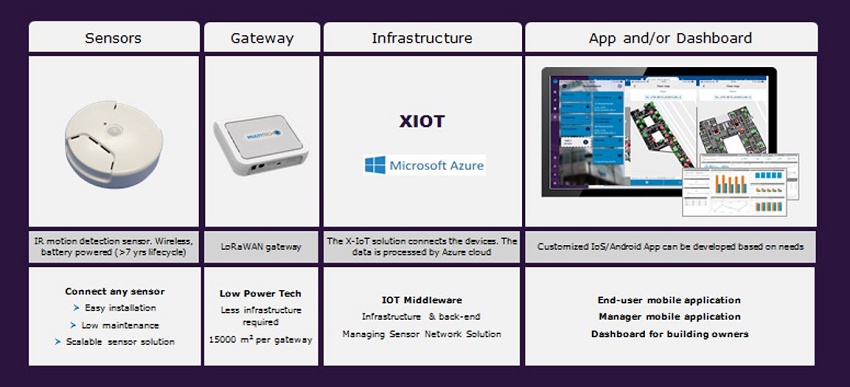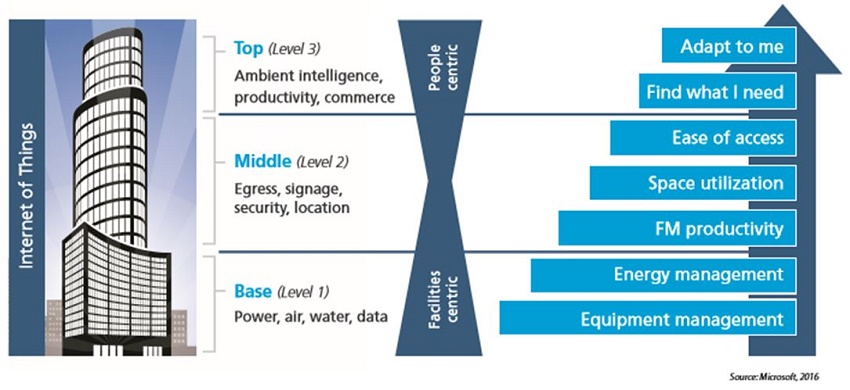|
August 2019
AutomatedBuildings.com
|
[an error occurred while processing this directive]
(Click
Message to Learn More)
|
|
The Backbone to
Smart Building Solutions
LoRa devices
and wireless radio frequency technology (LoRaŽ Technology) confronts
this challenge through a long-range, low-power wireless radio frequency
platform.
|

Byron BeMiller,
Vertical Lead for Smart Buildings
Semtech
|
In the connected era,
an increasing number of IoT solutions
will make our homes, public areas and workplaces, smarter. Building
managers will have access to real-time, cloud-based analytics,
reporting and services, allowing for informed decision making. With the
increasing market demands for cost-saving occupancy comfort solutions,
connected technologies are well-positioned to meet the needs of the
automated building industry.
From fire detection to temperature control and energy management, these
applications are a part of a growing market. In fact, Allied Market
Research forecasts that by 2024, the global intelligent
building market will be valued at over $42 billion. Additionally, a
recent Research and Markets report estimates that over 483 million IoT-based building
solutions will be installed by 2022. To support this growth, IoT-based
building solutions require reliable technology that will enable full
use of its connective capabilities in a complex environment.
For real-time analytics, data transmission will require secure networks
with a wide reach and low power consumption. LoRa devices
and wireless radio frequency technology (LoRaŽ Technology) confronts
this challenge through a long-range, low-power wireless radio frequency
platform. The versatility of LoRa Technology enables it to function in
dense urban environments, providing connectivity to even below ground
concrete facilities, making it an ideal IoT solution for the automated
building industry.

Figure
1: LoRaŽ Network Breakdown
A LoRa-based IoT solution begins with a LoRa-enabled embedded sensor.
This could take the form of smoke and leak detectors, to room occupancy
sensors. The embedded sensor is connected to a low power, wide
area network (LPWAN) gateway application, a key hub in which multiple
sensors will send initial data to. The data will then be sent to a
network server and routed to application servers or cloud IoT services.
These applications interpret the data collected from the embedded
sensors using techniques such as machine learning and artificial
intelligence, providing valuable information to the end-user securely.
Let’s explore some examples of LoRa-based smart building solutions.
Fire Detection
Fires cause roughly $10 billion in property damage in the U.S. In a
commercial building setting, a fire can rapidly spread in a matter of
minutes, making early detection key to maintaining the safety of
building occupants and reducing the damage to the property. By
utilizing a network of fire and smoke detecting LoRa-based sensors,
firefighters are provided with real-time data to effectively combat a
fire outbreak.

Figure 2.
LoRa-Based Fire
Detection Deployment
Embedded
sensors are able to detect rapid thermal changes, smoke and
gas. Through the connected network, information on where the fire is
heading to, as well as the scale, is routed to emergency services. By
using this data, first responders are able to prepare the most
effective response while targeting key areas, saving valuable time.
Smart Offices
In today’s competitive market, a low-cost scalable solution is
necessary to meet the challenge of outfitting multiple offices for the
connected era. To address this, Capgemini’s Corporate Real Estate Services
developed a line of LoRa-based IoT solutions to monitor over 400 office
buildings in more than 40 countries.

Figure 3. Capgemini’s LoRa-Based IoT Platform
Using
low-maintenance and easy to install sensors, Capgemini is able to
consistently and accurately monitor real-time comfort information such
as temperature, humidity, carbon dioxide levels and noise.
Additionally, data provided by the deployments were able to solve
no-shows in 30% of meeting rooms, improve sustainability through
rightsizing offices and reduce energy consumption. Information is
accessible through a smartphone app or dashboard, simplifying tasks
such as booking empty meeting rooms, turning off lights in unused
spaces and accessing environmental controls. The sensors supplying all
this information can last up to 7 years thanks to its low-power
consumption, making them ideal for large deployments requiring a wide
area network.
Radiation detection
It’s estimated that nuclear power plants supply 20
percent of the nation’s power, with nearly three million Americans
living within ten miles of an active nuclear power plant. Despite
providing energy to many Americans, these power plants pose a major
danger to those working in or near the surrounding area. A radioactive
leak can be deadly, causing multiple health complications. Radiation
leaks cannot be detected through human senses; managers must deploy
embedded sensors capable of detecting radiation leaks throughout
nuclear facilities, surrounding buildings and the larger community. A
LoRaWAN deployment is able to constantly measure radiation levels to
ensure a safe work environment for employees.

Figure 4. LoRa Based Radiation Detection Deployment
Through
the deployment pictured above, sensors and gateways embedded
with LoRa Technology can monitor radiation levels beyond the power
plant, providing ease of mind to tenants within surrounding buildings.
Batteries for radiation sensors can last up to 10 years, providing a
low maintenance connected solution to a serious health risk.
Looking Ahead
IoT solutions for smart buildings have grown in versatility and evolved
to meet the new industry demands by building tenants. Solutions will
soon be personalized for individual needs, contributing to productivity
and further improving workspace quality.

Figure 5. IoT Smart Building Solution Progression
As
more investment will be directed towards smart building solutions,
LoRa architecture will continue enabling hundreds of sensors to connect
to a network in a cost-effective way. The versatility of these
solutions allows applications to be deployed in new buildings or
retroactively implemented. As new technologies emerge, it will be
interesting to see how IoT connectivity solutions and cloud-based
analytics will be leveraged in different ways to provide real value to
building managers.
About
the Author
Byron
BeMiller is the vertical lead for Smart Buildings at Semtech and the head of the
LoRa Alliance Smart Building Working Group. He is the former VP
of Sales at TrackNet, an IoT solutions provider which was acquired by
Semtech. Prior to TrackNet, Byron had spent the previous 7 years
at Semtech where he held a variety of Business Development and Product
Marketing positions. Previous to Semtech, Byron held Sales and Business
Development management positions at Ciena and Nortel Networks. He holds
a BSEE from the University of Illinois and an MS in Management from
Georgia Tech.
footer
[an error occurred while processing this directive]
[Click Banner To Learn More]
[Home Page] [The
Automator] [About] [Subscribe
] [Contact
Us]
